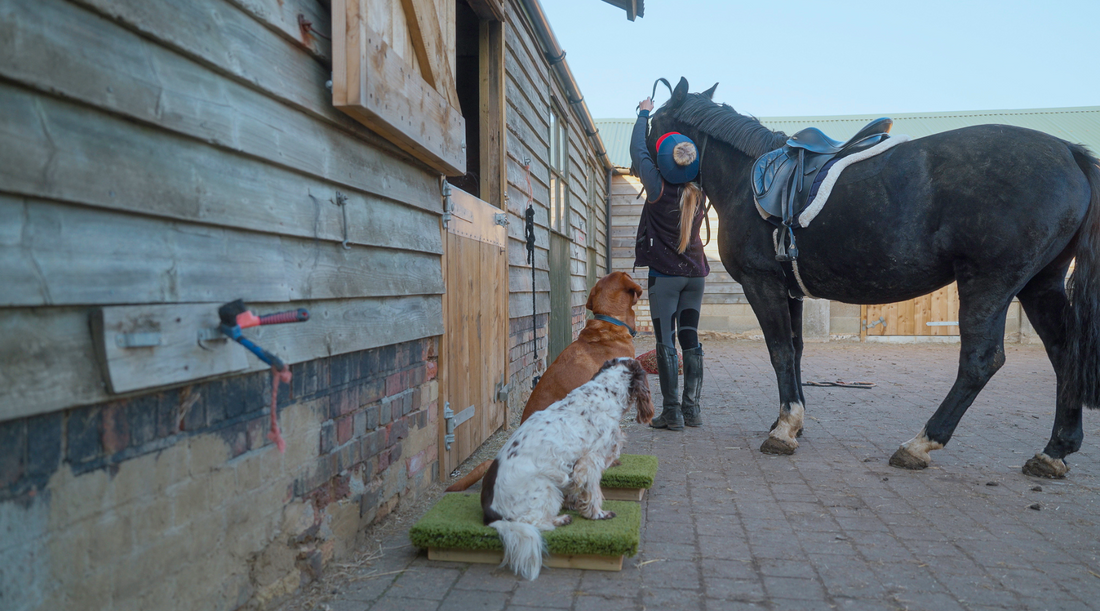What is a Place Board for Dogs?
Training a dog to focus, follow commands, and excel in specific tasks can be challenging, especially if they are high-energy or easily distracted. One powerful tool for achieving steady focus and positioning is the dog place board. This training platform helps dogs understand spatial boundaries and gives trainers a precise way to direct behaviours. In this guide, we'll explore how dog place boards work and why they're an invaluable tool in dog training, especially for obedience, agility, and gundog training.
What is a Dog Place Board?
A place board is a raised platform designed to act as a target for dogs, providing a defined space where they are expected to go and stay. For instance, a dog may be directed to sit on the board until given another command. This simple yet effective tool is commonly used in gundog training and general obedience training. Its distinct surface helps dogs differentiate it from their surroundings, reinforcing their understanding of where to be during exercises.
How Place Boards Benefit Dog Training
1. Clear Communication Through Targeted Training
Place boards simplify training cues by offering a consistent target for dogs, making it easier for them to interpret commands. In the T.A.R.G.E.T training method (as used by Anglian Dog Works), the place board acts as a point of reference for various behaviours such as sit-stay, recall, and heel. This method reduces confusion and encourages dogs to develop reliable behaviours by consistently reinforcing the correct position.
2. Reinforcing Positive Behaviours
With a place board, dogs can repeat and refine desired behaviours. Since they receive treats for sitting or staying on the board, the behaviour becomes a habit. For example, a gundog using a place board learns to wait in a specific location until given a release cue, creating a reliable response even during high-energy activities.
3. Increasing Focus and Stability
Dogs trained on place boards develop improved focus and patience. During training, a dog is rewarded only when they are in a sit on the board. This approach teaches them to hold a position, even if the handler steps away. Over time, place board training strengthens steadiness and makes the dog more responsive to cues in different environments.
How to Introduce Place Boards in Dog Training
Place board training can be broken down into simple steps, starting with familiarization and progressing to advanced drills. The Anglian Dog Works training system incorporates these phases for effective place board use:
Phase 1: Teach the Basics
Initially, dogs are guided onto the board using a food lure. The handler walks with the dog toward the board, prompting the dog to step up and sit. Once the dog reaches the board and sits, they're rewarded, associating the board with positive reinforcement.
Phase 2: Build Positive Associations
The next step is to ensure the dog naturally returns to the place board. After releasing them from the board with a treat, handlers observe whether the dog voluntarily returns to the platform. This repetition strengthens the dog’s understanding that the board is a “positive space” associated with rewards.
Essential Training Exercises Using Place Boards
1. Sit-Stay for Steadiness
A sit-stay drill on a place board is ideal for testing steadiness and self-control. In a basic sit-stay exercise, the handler positions the dog on the board, then steps away. The dog must remain seated until the handler returns or calls them over, reinforcing obedience in real-world situations.
2. Recall with Place Boards
Reliable recall is crucial, especially for dogs in sports. By incorporating a place board, dogs learn to return straight to a specific location, helping eliminate the common issue of circling or dancing just of of reach from the handler.
3. Distance and Directional Training
Place boards can be used to teach dogs how to respond to commands from a distance. Once the dog is comfortable with being on the board, the handler can increase the distance. This technique is particularly valuable for gundog training and agility, where a quick response to directional cues is essential.
Advanced Training Techniques with Place Boards
Once dogs are comfortable with basic commands, handlers can introduce more complex training exercises to improve responsiveness and obedience. Here are some examples:
Sending the Dog to the Board
The handler gradually increases the distance from which they send the dog to the board. This technique allows the dog to practice targeting the board from afar, helping it develop independence and accurate positioning. Eventually, the dog can be sent to the board from various distances; a useful skill when teaching gundog casting, or thinking about distance handing in agility for example.
Distraction Training
Introducing distractions while the dog remains on the board can greatly enhance their focus. A trainer might throw a toy or make sounds, testing the dog’s steadiness. Dogs who can hold their position despite distractions demonstrate a high level of discipline and readiness for complex tasks.
Extended Sit-Stays
Gradually extending the time a dog stays on the place board helps them build endurance in holding commands. Starting with a few seconds and slowly increasing the duration, this exercise trains dogs to stay attentive and wait patiently. This skill is necessary for when a gundog joins a gun on a peg.
Frequently Asked Questions
What is a Place Board Used for in Dog Training?
A place board offers dogs a designated area where they are expected to perform specific commands, such as sit, stay, or heel. It provides a visual and physical boundary, which helps dogs understand their positioning relative to the handler. For trainers, it’s an excellent way to reinforce commands consistently.
Is Place Board Training Suitable for All Dogs?
Yes! Place board training is beneficial for dogs of all ages and breeds. It’s particularly useful for gundogs and active breeds, but it can also be adapted for obedience and focus training in family pets.
How Long Does it Take to Train a Dog on a Place Board?
Training duration depends on the dog’s temperament and previous experience. Many dogs understand the basics within a few sessions, and with regular practice, they can reliably perform place board exercises within a few weeks.
Get Started with Anglian Dog Works Place Board Training
At Anglian Dog Works (ADW), we specialize in place board training for dogs at all skill levels. Our signature T.A.R.G.E.T system makes learning easy for both handlers and dogs, ensuring successful training outcomes. Click either of the links above to learn more about our approach to training and find resources for building a lasting bond with your dog.





